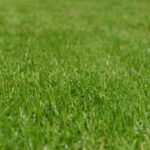 With the shocking report in recent days from the Intergovernmental Panel on Climate Change (IPCC) on climate change, and with the extreme recent weather we are all experiencing such as flooding and heatwaves, it is becoming more obvious that the way we look after our lawns has to be adapted to mirror these changes. Grasses as we know adapt naturally, but how we care for them needs to fit in with extra demands.
With the shocking report in recent days from the Intergovernmental Panel on Climate Change (IPCC) on climate change, and with the extreme recent weather we are all experiencing such as flooding and heatwaves, it is becoming more obvious that the way we look after our lawns has to be adapted to mirror these changes. Grasses as we know adapt naturally, but how we care for them needs to fit in with extra demands.
Lawns, often the largest and most visible areas of the garden, illustrate the impacts of extreme weather most clearly, just look at all the images over the summer of hidden historical gardens such as Gawthorpe Hall in Lancashire that reappeared after the record temperatures.
So should we be worried about our lawns? Let’s remember two facts, one, grass is one of the most resilient plants and two, good lawn care is about working with not against nature. So let’s look at weather types:
Drought
After long dry periods, your lawn can look like a dead wilderness but it will revive. But you need to look at the soil, in drought conditions the soil can shrink when the air is being squeezed out. That is why aeration is so important, following your usual routine or doing it at the same time as scarifying or overseeding. And watering? Much better to leave this to nature, eventually natural rainfall will bring the soil moisture back to normal.
Rain
If your lawn has been flooded, don’t leap in too soon. The water will eventually drain through and when it does you don’t need many rain free days for the ground surface to become drier. But you will need to aerate more regularly than you usually do, as the excessive water will have squeezed out the air from the soil. But first, allow time for the soil to drain, working on saturated soil will do more harm than good.
Snow & Frozen Ground
When the ground is frozen nothing happens, the air and the water in the soil will still be there. And if the lawn also has a blanket of snow for any length of time, nothing especially bad will come from this. However, if snow is lying on non frozen soil, this can create a warm canopy over the ground. This in turn produces the ideal environment for disease pathogens to activate. So once he snow has thawed, keep a vigilant eye out for signs of disease.
And remember grass is a plant and it takes up carbon dioxide out of the atmosphere. Carbon dioxide is a greenhouse gas and if we sequester it, we can help to remove it from the atmosphere.
So, even when you think your lawn has stopped growing, its still does it’s bit for the environment. Adaptive grasses need no help. Our methods just need to adapt a bit too.
www.davidhedges-gower.com

